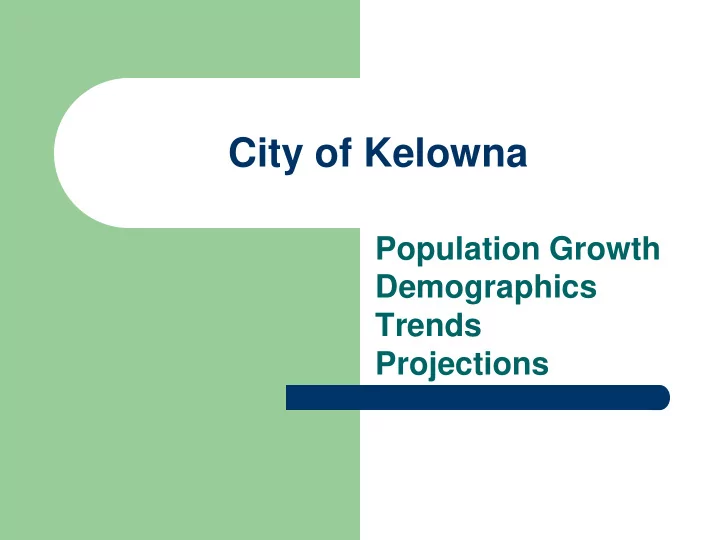

City of Kelowna Population Growth Demographics Trends Projections
Historic Population Growth Average Annual Growth Rate – 2 to 2.5% (1973 Amalgamation – 2006 Census) Average growth rates disguise short term fluctuations Population doubled from 50,000 to 107,000 1981 – 1986 growth rate was approx. 0.7% 1988 – 1994 growth rate was approx. 6.0% 1996 – 2004 growth rate was approx. 2.0%
Historic Population Growth 120,000 106,707 100,000 96,288 89,442 80,000 Population 75,950 60,000 61,213 59,196 51,955 40,000 20,000 19,415 0 1971 1976 1981 1986 1991 1996 2001 2006 Census Census Census Census Census Census Census Census Year
Single Family BP Issuances (1972-2008) 2004 2000 1992 1982 1974 1000 900 800 700 600 500 400 300 200 100 0
Historic Demographics Population Data (1981 – 2006) Year 1981 1986 1991 1996 2001 2006 Population under 15 19 % 18 % 19 % 18 % 17 % 15.4 % Population over 65 16 % 18 % 19 % 18 % 19 % 19.5 % Male / female (%) 48/52 48/52 48/52 48/52 48/52 48/52 Average family unit 3.0 2.8 2.8 2.8 2.8 2.7 Average household size 2.7 2.5 2.4 2.4 2.3 2.26 Total Population 59,196 61,213 75,950 89,442 96,288 106,707 Source: Statistics Canada: Census 1981, 1986, 1991, 1996, 2001, 2006
Population Trends • Historical 30 year average annual growth rates of approximately 2.5% • More recent trends are on the order of 2.1% population growth per year • Increasing seniors and early retirement population • Decline in number of children
Population Trends • Decline in number of young adults (moderated by growth at UBCO and OC) • Recent increase in adults between 35 – 55 attracted by employment opportunity • Decline in average household size (moderated by sharing, blended families, elderly care)
Population Projections Assumptions: • We will all be a year older next year • Excluding migration, there will not be any more 20 year olds next year than we have 19 year olds this year • Birth / death rates and aging explain only part of the future • Migration will continue to be the most important component of population growth
Population Projections Death rates will continue to increase and birth rates will continue to fall Beginning in 2011 it is projected that for the first time death rates will be higher than birth rates Population growth will occur as a result of natural increase and migration of retirees prior to 2011 Migration alone will be the determinant of growth beyond 2011 due to retirees and younger labour force migrants
Population Projections A greater level of amenities and services will continue to attract seniors to the City Continued economic growth will attract working age people to new jobs and jobs vacated by retirees A short term increase in young adults will result from students attending UBCO and OC May be balanced by significant employment and residential growth (due to improved access/new bridge) on the Westside, particularly on First Nations lands
Population Projection 180,000 161,701 Proj. 160,000 152,038 140,000 141,689 Proj. 130,750 Proj. 120,000 118,657 Proj. Population Proj. 106,707 100,000 Proj. 80,000 60,000 40,000 20,000 0 2006 Census 2010 (Proj) 2015 (Proj) 2020 (Proj) 2025 (Proj) 2030 (Proj) Year
Comparison to Other Regions Source: BC Stats 5 Central OK North OK 4 OK - Similkameen Thompson - Nicola Fraser - Ft. George 3 Capital RD Nanaimo RD Percentage 2 City of Kelowna 1 0 2002 2003 2004 2005 2006 2007 2008 2009 2010 2011 2012 2013 2014 2015 2016 2017 2018 2019 2020 2021 2022 2023 2024 2025 2026 2027 2028 2029 2030 -1 -2 Year
Demographic Projection Age Breakdown for RDCO Population (2006 and 2030) Source: B.C. Statistics Regional District Population Projection (PEOPLE 32 – August 2007) 90+ 85 - 89 2030 80 - 84 2006 75 - 79 70 - 74 65 - 69 60 - 64 55 - 59 50 - 54 ge 45 - 49 A 40 - 44 35 - 39 30 - 34 25 - 29 20 - 24 15 - 19 10 - 14 5 - 9 0 - 4 0 2,000 4,000 6,000 8,000 10,000 12,000 14,000 16,000 18,000 20,000 Population
Household Size Projections Average household size in 1981 was 2.7 In 1991 its was 2.4 and in 2001 it was 2.3 Average household size in 2006 was 2.26 Average household size is projected to fall to 2.16 by 2020 and to 2.11 by 2030 The 20 year projected average would be 2.18
Population Projection “Projections do not give a precise statement of what the future will bring, but rather, they provide information about what might happen under a set of stated circumstances”. Projections are intended “to capture the nature and magnitude of the directions of change”. Projections provide an opportunity to influence the future outcome to match the vision or to “avoid a future that may not be desirable”. Source: David Baxter, Andrew Ramlo, Elana Rosenberg; Housing the Central Okanagan Regional District’s Future Population: Demographics and Demand, 1996 to 2026; Urban Futures Institute and The Land Centre, 1998
Population Projection 2009 projected population is over 116,000 people Projected population in 2030 will be almost 162,000 That means there will be almost 45,500 new people in Kelowna by 2030
How do we use demographic trends / population projections? At an average household size of 2.18 we will need almost 21,000 new housing units by 2030 We need to plan where all those people will live, shop, and play We need to plan in what type of housing all those people will live We need to plan how we will provide services such as roads, transit and other utilities
What’s the Goal? To create an accessible, affordable, complete, liveable and sustainable community for all who choose to live here
Recommend
More recommend